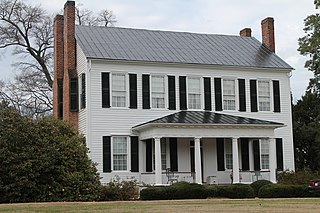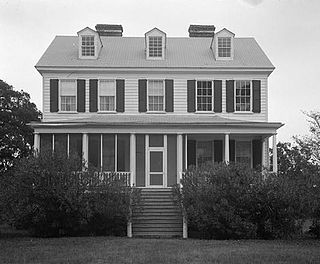
Pender County is a county located in the U.S. state of North Carolina. As of the 2020 census, the population was 60,203. Its county seat is Burgaw. Pender County is part of the Wilmington, NC Metropolitan Statistical Area.
Hampstead is an unincorporated community and census-designated place (CDP) in Pender County, North Carolina, United States. It is located between Wilmington and Jacksonville on U.S. Route 17 and includes an area sized just over 20 square miles.

Cape Fear is a coastal plain and Tidewater region of North Carolina centered about the city of Wilmington. The region takes its name from the adjacent Cape Fear headland, as does the Cape Fear River which flows through the region and empties into the Atlantic Ocean near the cape. Much of the region's populated areas are found along the Atlantic beaches and the Atlantic Intracoastal Waterway, while the rural areas are dominated by farms and swampland like that of the Green Swamp. The general area can be also identified by the titles "Lower Cape Fear", "Wilmington, NC Metropolitan Statistical Area", "Southeastern North Carolina", and "Azalea Coast". The latter name is derived from the North Carolina Azalea Festival held annually in Wilmington. Municipalities in the area belong to the Cape Fear Council of Governments.
Rocky Point is a census-designated place and unincorporated community in southern Pender County, North Carolina, United States. It is part of the Wilmington Metropolitan Statistical Area. Rocky Point is situated on North Carolina Highway 210, North Carolina Highway 133 and U.S. Route 117.

Rose Hill Plantation House is an historic Carpenter Gothic house located on US 278 in Bluffton, Beaufort County, South Carolina. It was begun in 1858 for Dr. John Kirk and Caroline Kerk, his wife, but construction was interrupted by the Civil War and not resumed until after World War II when it was renovated and finished by architect Willis Irvin for John Sturgeon and Florence Sturgeon, his wife. On May 19, 1983, it was added to the National Register of Historic Places. It preserves the antebellum plantation home of Dr. & Mrs. John William (1803-1868) & Caroline (1815-1864) Kirk, a wealthy planter and physician.

Mount Mourne Plantation is a former Southern plantation and historic house located in Mount Mourne, Iredell County, North Carolina. It was built in 1836, and is a two-story, five-bay transitional Federal / Greek Revival style frame dwelling. It features a hipped roof entrance portico with four fluted Tuscan order columns.

Sloop Point Plantation is a historic house located at Sloop Point, Pender County, North Carolina. It was built in 1729 according to dendrochronological dating and is possibly the oldest surviving framed building in the state of North Carolina. The house was built as a home for John Baptista Ashe and his wife Elizabeth Swann Ashe.

Botany Bay Heritage Preserve & Wildlife Management Area is a state preserve on Edisto Island, South Carolina. Botany Bay Plantation was formed in the 1930s from the merger of the Colonial-era Sea Cloud Plantation and Bleak Hall Plantation. In 1977, it was bequeathed to the state as a wildlife preserve; it was opened to the public in 2008. The preserve includes a number of registered historic sites, including two listed in the National Register of Historic Places: a set of three surviving 1840s outbuildings from Bleak Hall Plantation, and the prehistoric Fig Island shell rings.

Cassina Point was built in 1847 for Carolina Lafayette Seabrook and her husband, James Hopkinson. Carolina Seabrook was the daughter of wealthy Edisto Island planter William Seabrook. William Seabrook had hosted the General Lafayette in 1825 at his nearby home at the time of Carolina's birth. Seabrook gave Lafayette the honor of naming the newborn child, and the general selected Carolina and Lafayette. When Carolina Seabrook married James Hopkinson, they built Cassina Point on the land given to them by William Seabrook.

Poplar Grove Plantation is a peanut plantation by the Topsail sound in Scotts Hill near Wilmington in Pender County, North Carolina. It was listed on the National Register of Historic Places listings in North Carolina on July 16, 1979.
Walston-Bulluck House, also known as the Pender Museum, is a historic home located at Tarboro, Edgecombe County, North Carolina. It was built about 1795, and is a one-story, three-bay, frame dwelling. It has a Hall and parlor plan and two reconstructed double-shouldered brick end chimneys. The house is sheathed in weatherboard, has a gable roof, and rests on a brick pier foundation. It was moved from its original location near Conetoe to its present site in 1969, and restored by the Edgecomb County Historical Society.
Henry Eccles House is a historic home located at Cool Springs Township, Iredell County, North Carolina. The house was built about 1861, and is a two-story, three bay by two bay, frame Greek Revival style dwelling. It has a low hipped roof, one-story rear addition, and two interior brick chimneys. Also on the property is a contributing log barn.
Bannerman House is a historic plantation house located near Burgaw, Pender County, North Carolina. It was built about 1840, and is a large two-story, five bay, "L"-shaped, Greek Revival style frame dwelling. It is sheathed in weatherboard and has a hipped roof pierced by three interior chimneys. The main facades each feature a one-bay pedimented portico, supported by colossal, flat-paneled pillars.
Beatty-Corbett House is a historic plantation house located near Ivanhoe, in Sampson County, Pender County, and Bladen County. The plantation is located at the tripoint of Sampson, Pender, and Bladen counties, with the house itself being located in Pender County. A two-story, side-hall Greek Revival style block was built about 1850, with a two-story, five bay, double pile Classical Revival house added about 1900, and a two-room ell added about 1920. The central bay of the c. 1900 section features a two-story portico. Also on the property are the contributing round-notched log stable, smokehouse, tool shed, washhouse, a sulfur spring, tobacco barn, several sections of ornate cast iron fence, the site of a former turpentine still, the site of a former riverboat landing, and the site of a former cotton gin.

Belvidere, also known as the Exum Newby House and Lamb House, is a historic plantation house located at Belvidere, Perquimans County, North Carolina. It was built about 1767, and is a 1+1⁄2-story, five bay, frame dwelling with an unusual hip on gambrel roof. The Georgian style dwelling is sheathed in weatherboard and rests on a brick pier foundation. In the mid-1970s, Belvidere was sold to radio personality Wolfman Jack.
Belvidere, also known as the Boyd House, is a historic plantation house located near Williamsboro, Vance County, North Carolina. It is attributed to architect Jacob W. Holt and built about 1850. It is a two-story, double-pile frame Greek Revival / Italianate style frame dwelling. It has a high hipped roof with bracketed eaves. The front facade features a full-width porch with hipped roof and brackets. Also on the property is a contributing one-story, heavy timber-frame school house.
Joseph John Pender House is a historic plantation house located near Wilson, Wilson County, North Carolina. The original section of the house was built about 1840 by Joseph John Pender, a large landowner and successful planter who was a member of a prominent landholding family. The house consists of a two-story, three bay, Federal frame section and a one-story frame kitchen/dining room ell. Also on the property are the contributing frame well structure and two tobacco barns.












